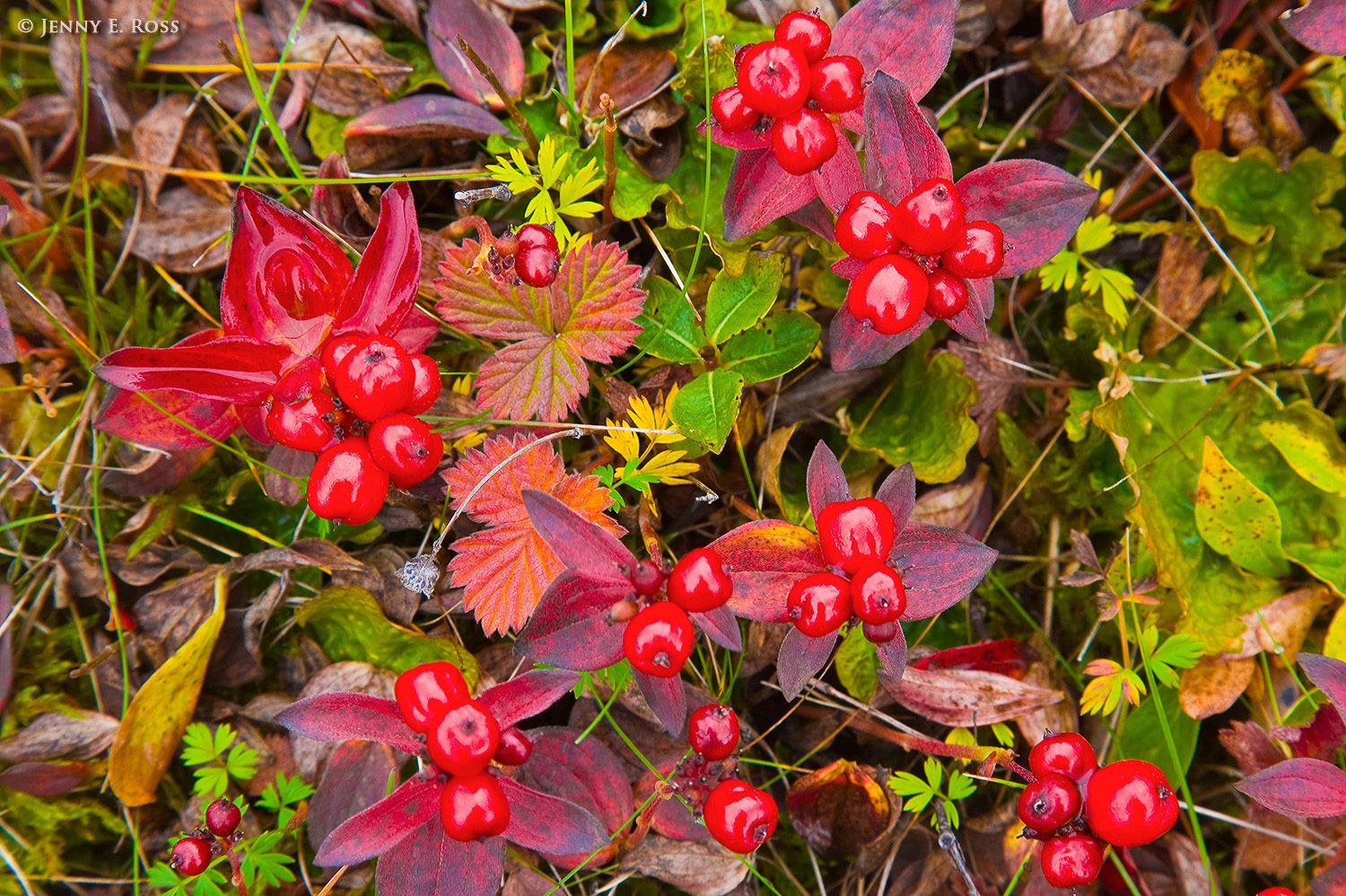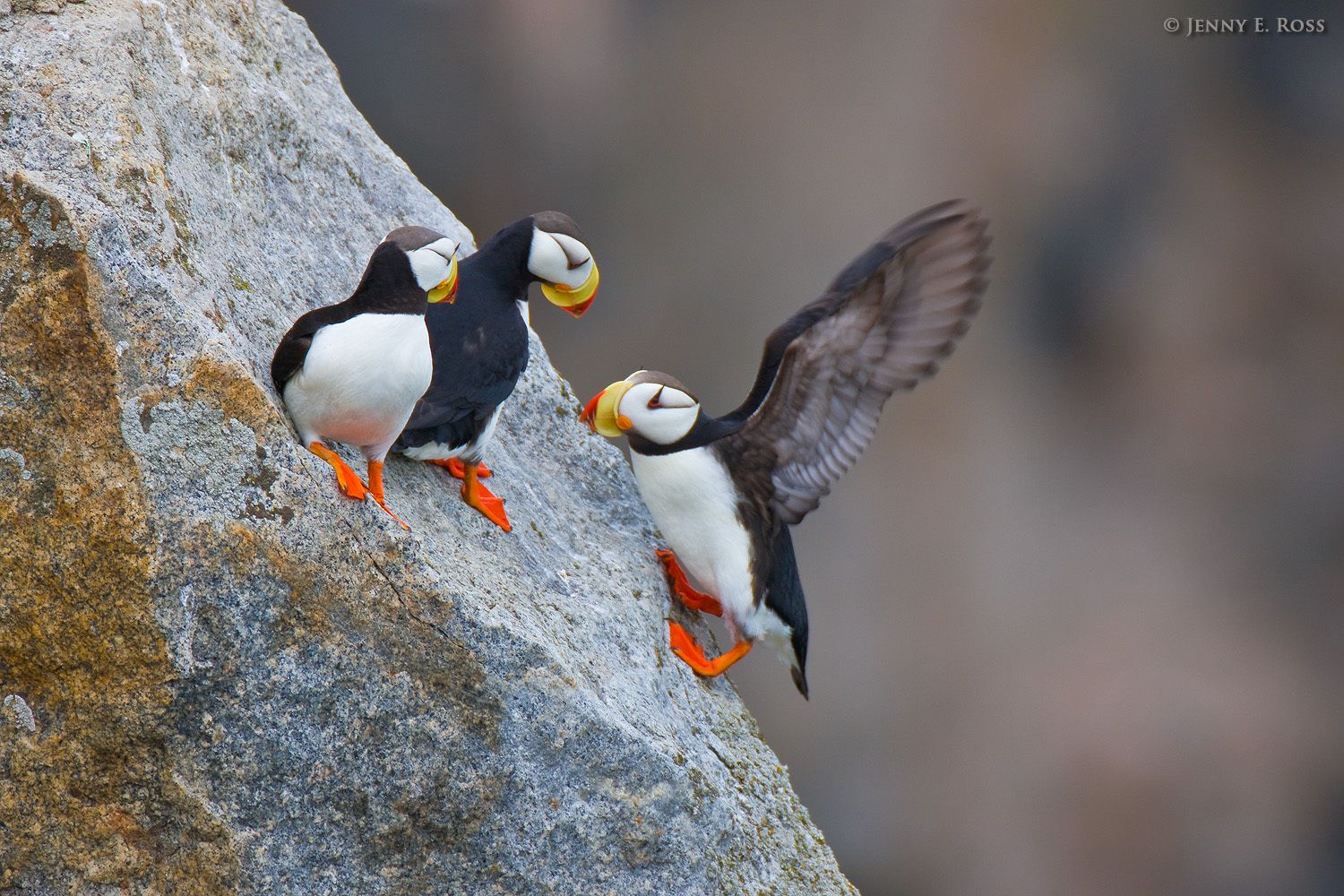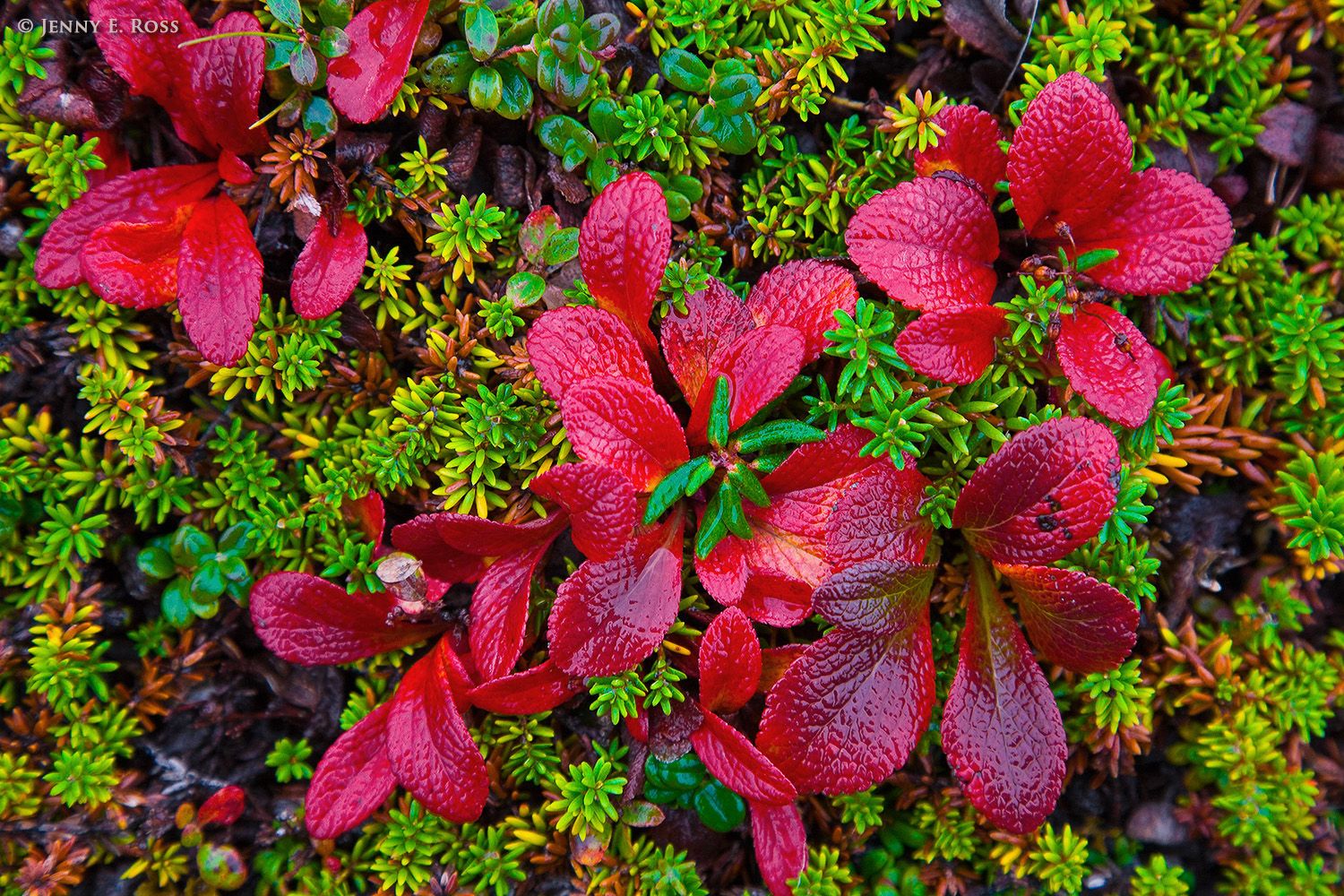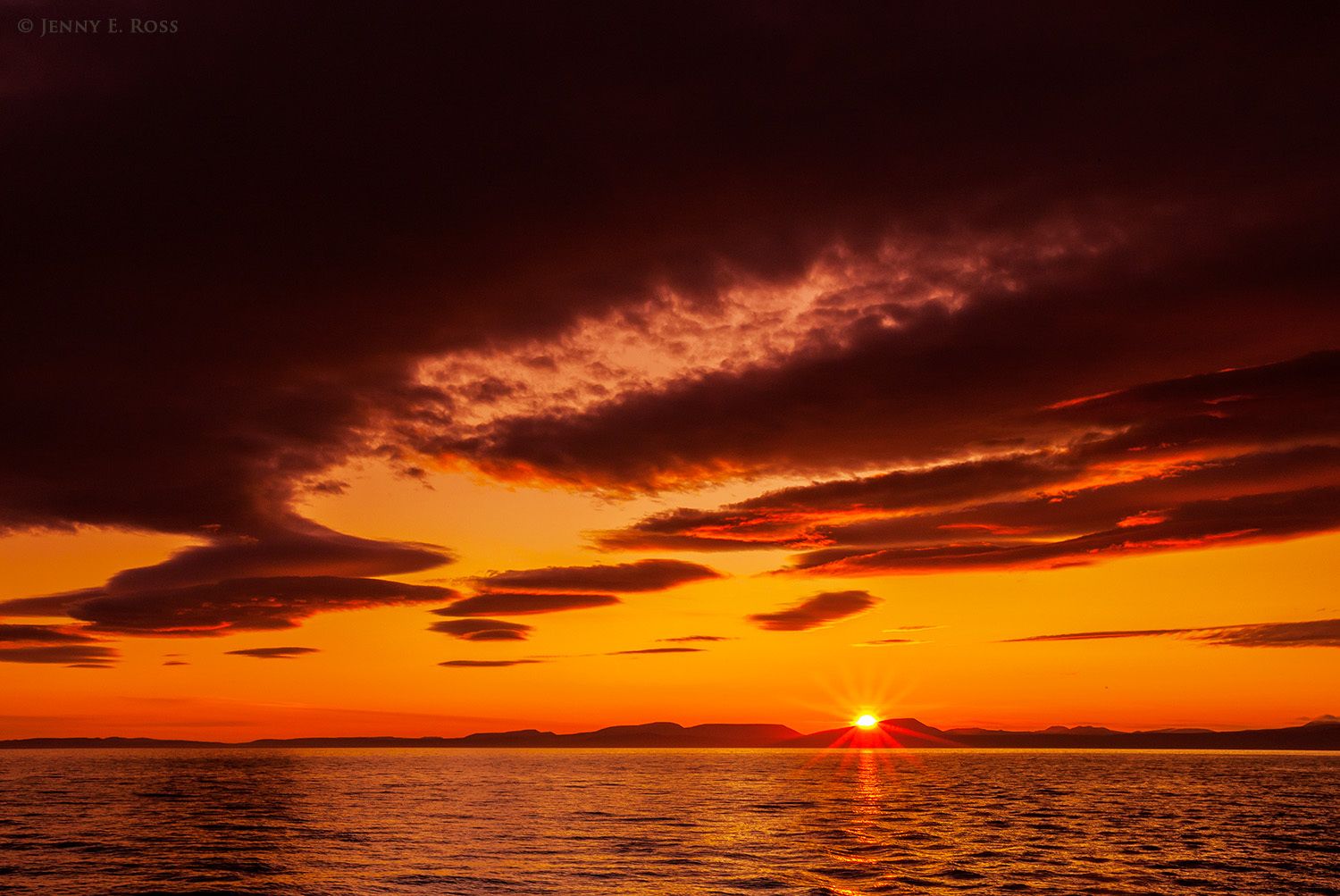-
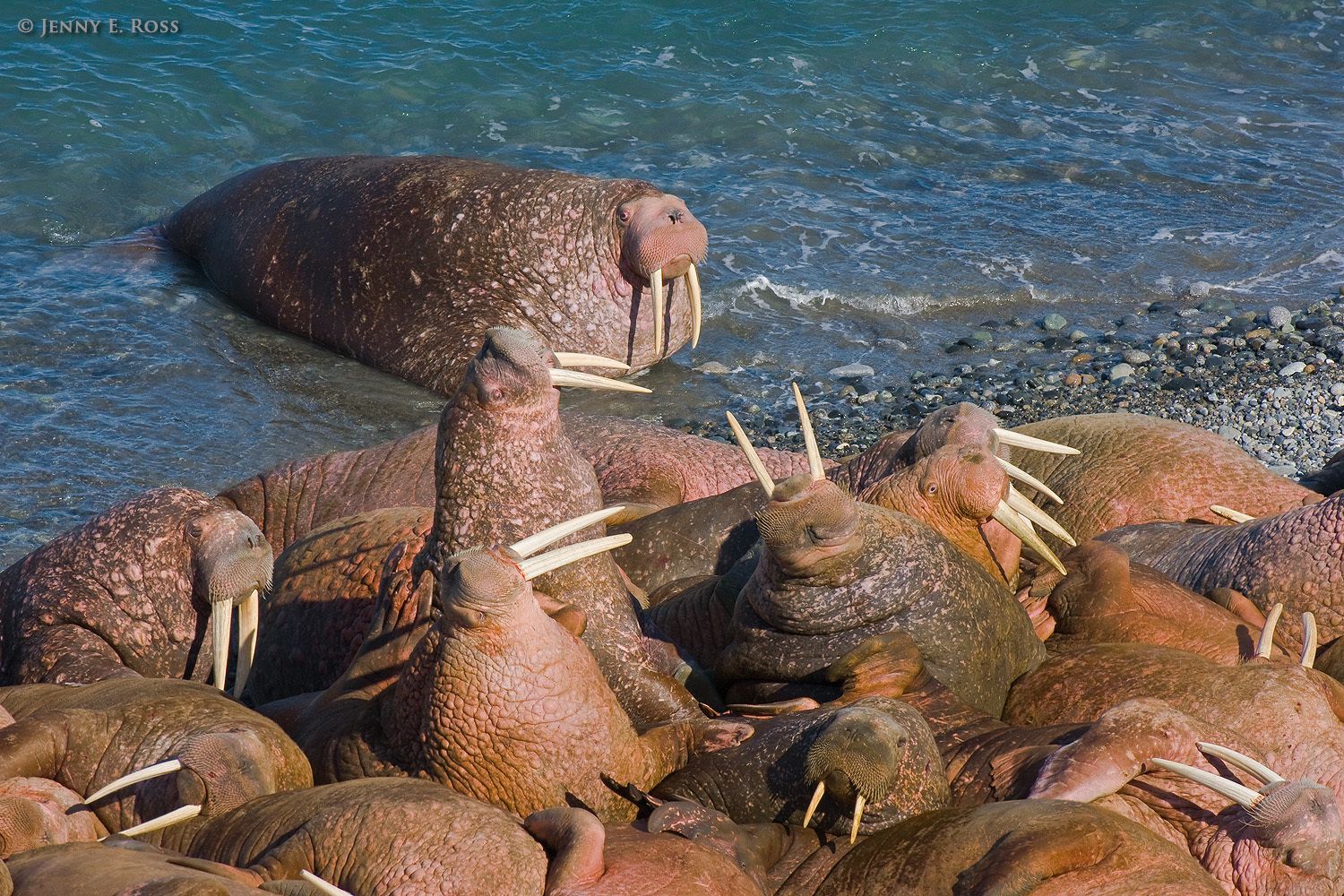
Pacific Walruses, Arakamchechen Island, Bering Sea, Russia
Pacific Walruses (Odobenus rosmarus divergens) maneuver for position at a small haul-out on the shore of Arakamchechen Island in the Bering Sea, Chukotka, Russia. The Pacific Walrus is an Arctic marine mammal that is dependent on the existence of sea ice for resting and breeding.
-
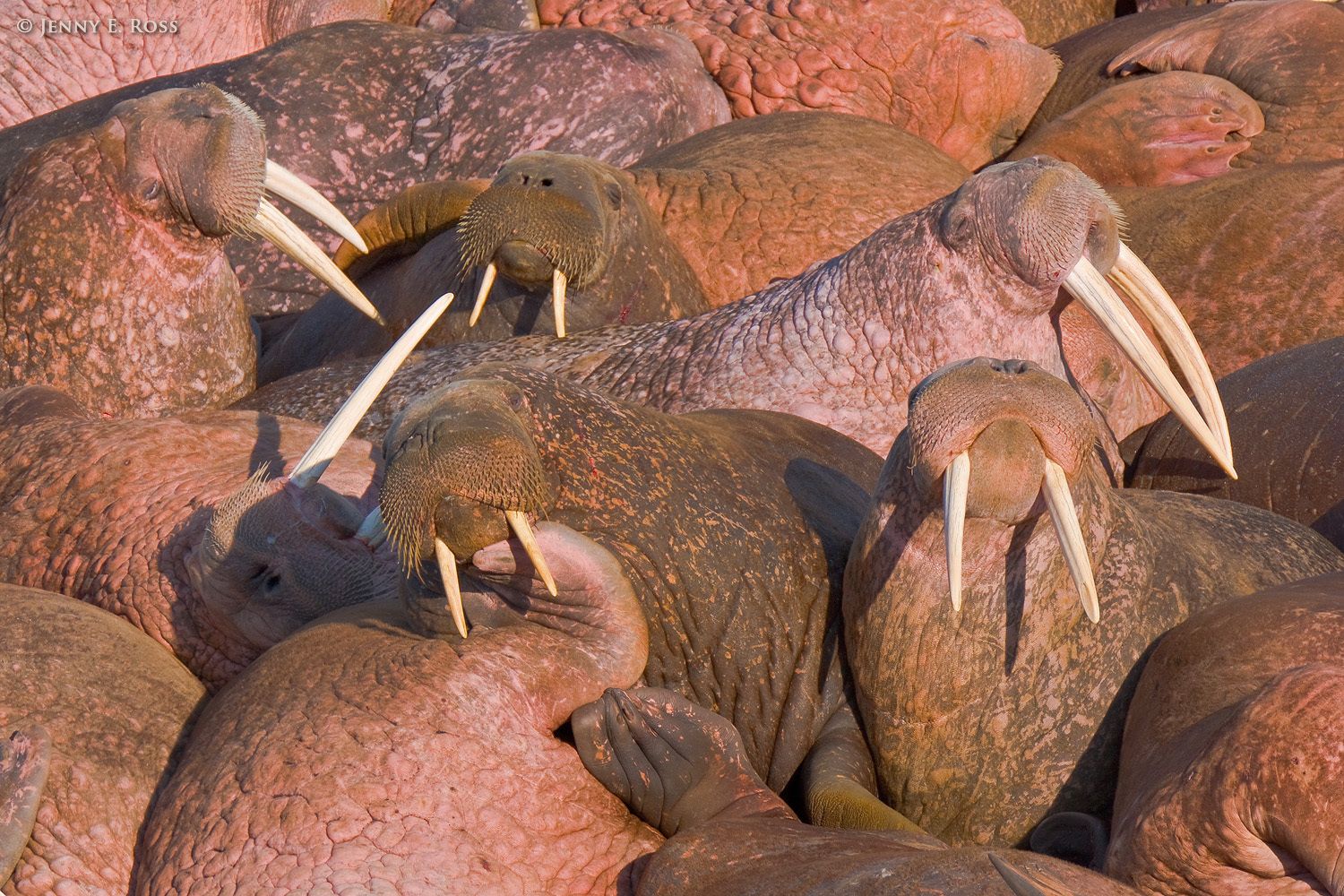
Pacific Walruses, Arakamchechen Island, Bering Sea, Russia
Pacific Walruses (Odobenus rosmarus divergens) maneuver for position at a small haul-out on the shore of Arakamchechen Island in the Bering Sea, Chukotka, Russia. The Pacific Walrus is an Arctic marine mammal that is dependent on the existence of sea ice for resting and breeding.
-
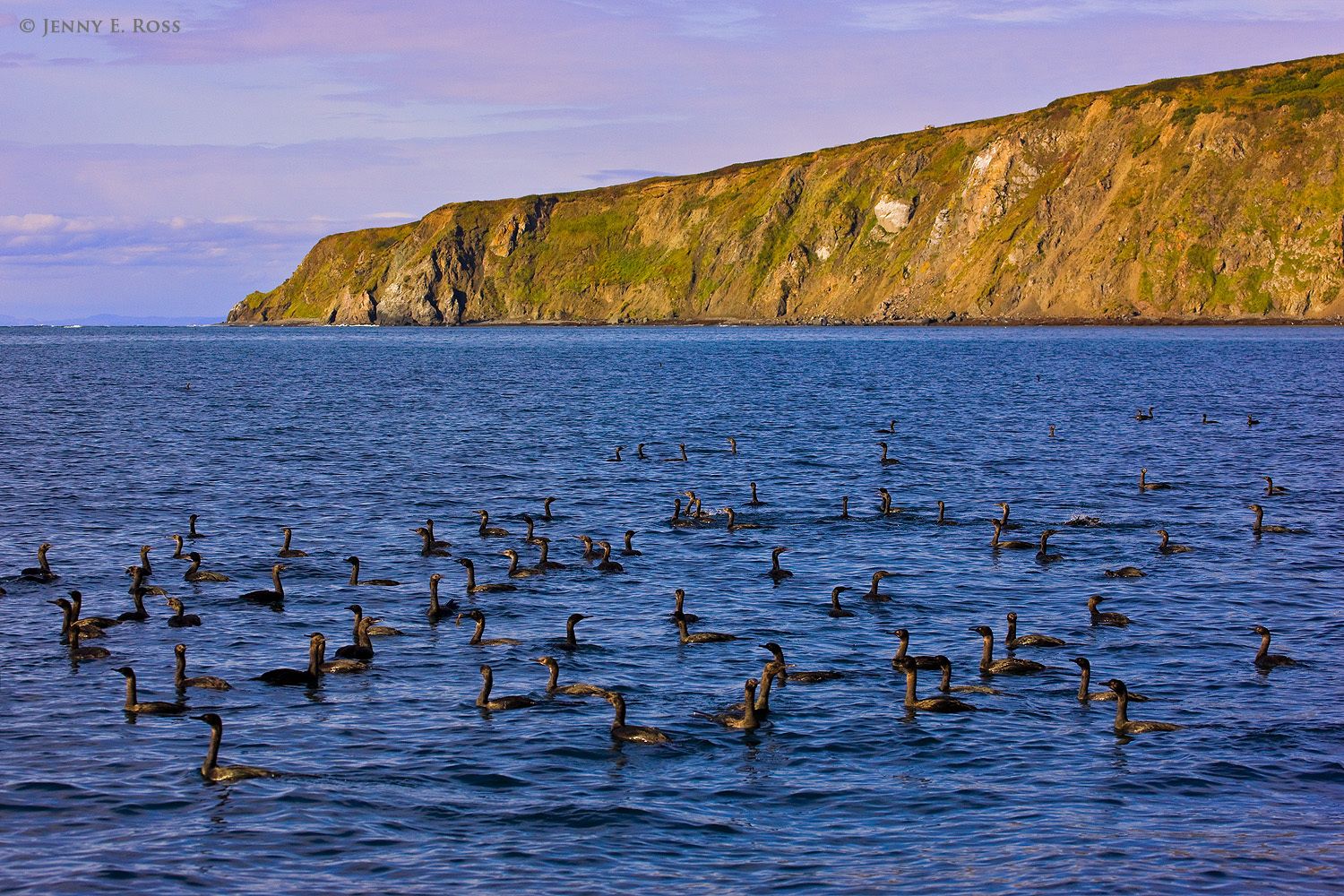
Pelagic cormorants, Verkhoturova Island, Bering Sea, Russia.
A flock of immature pelagic cormorants (Phalacrocorax pelagicus) swim in the Bering Sea near Verkhoturova Island, Kamchatka, Russia. Verkhoturova Island is a tiny island only 3.5 km long, located 45 km north of Karaginsky Island, in the Karaginsky Gulf of the Bering Sea. Russia's Kamchatka Peninsula is 40 km west of Verkhoturova and Karaginsky Islands, across the Litke Strait.
-
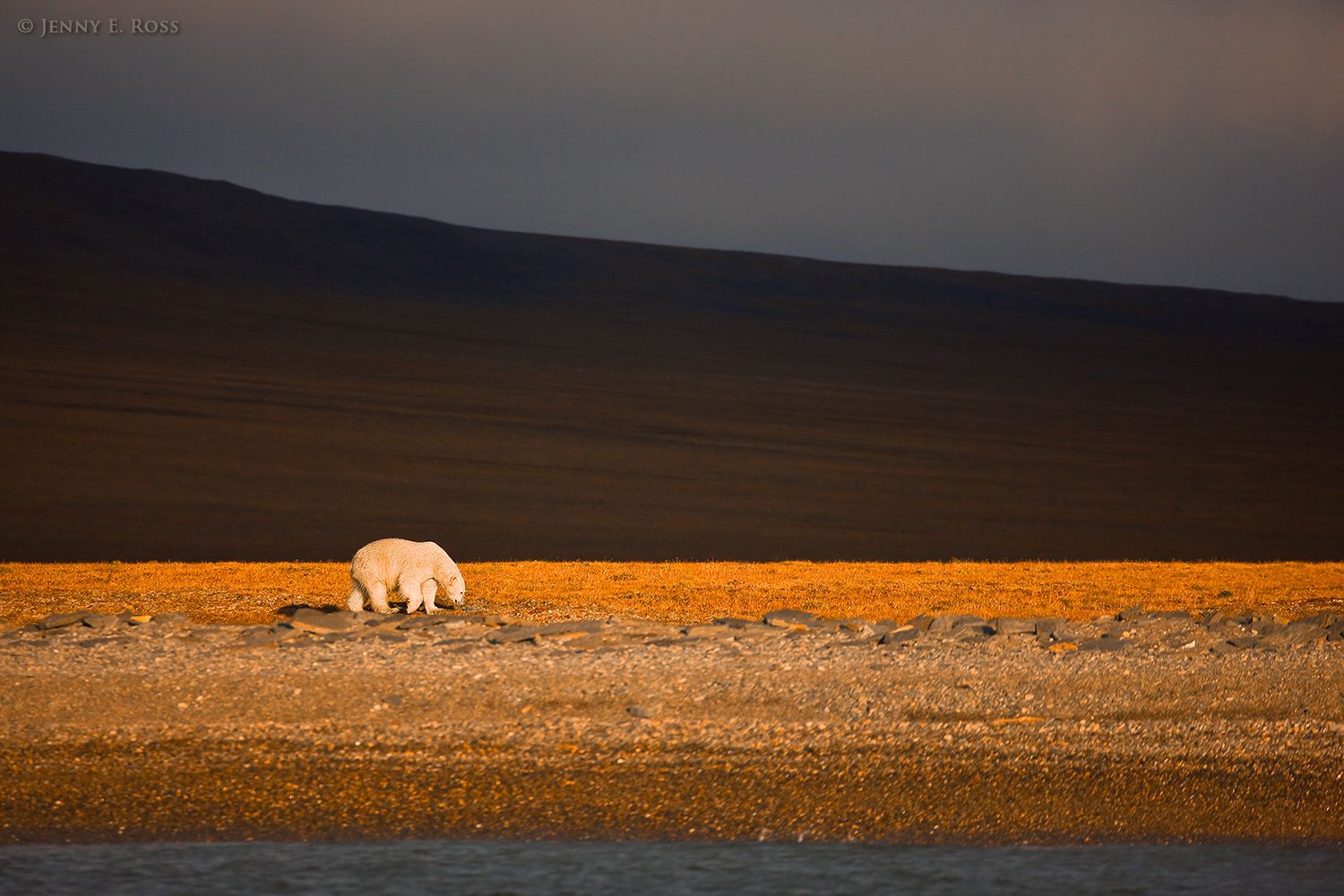
Polar bear at sunset on Wrangel Island, Russian High Arctic.
A young adult male polar bear (Ursus maritimus), illuminated by dramatic light at sunset as a storm approaches, walks along the shore of Wrangel Island in the Russian High Arctic. The slope of Dreamhead Mountain is behind the bear on the left side of the photograph. The bear was marooned on land, food-deprived, because the sea ice had melted in the region and receded far to the north. Polar bears require sea ice for all essential aspects of their lives; they cannot hunt seals, their primary prey, in the absence of sea ice. The polar bear is listed as a Threatened species under the U.S. Endangered Species Act, and it is designated as Vulnerable on the IUCN Red List. It is threatened with extinction due to loss of its sea-ice habitat as the result of climate change. Wrangel Island is located in the Arctic Ocean north of Siberia, where the East Siberian Sea meets the Chukchi Sea. It is protected as a federal Nature Reserve in Russia and is also a UNESCO World Heritage Site.
-
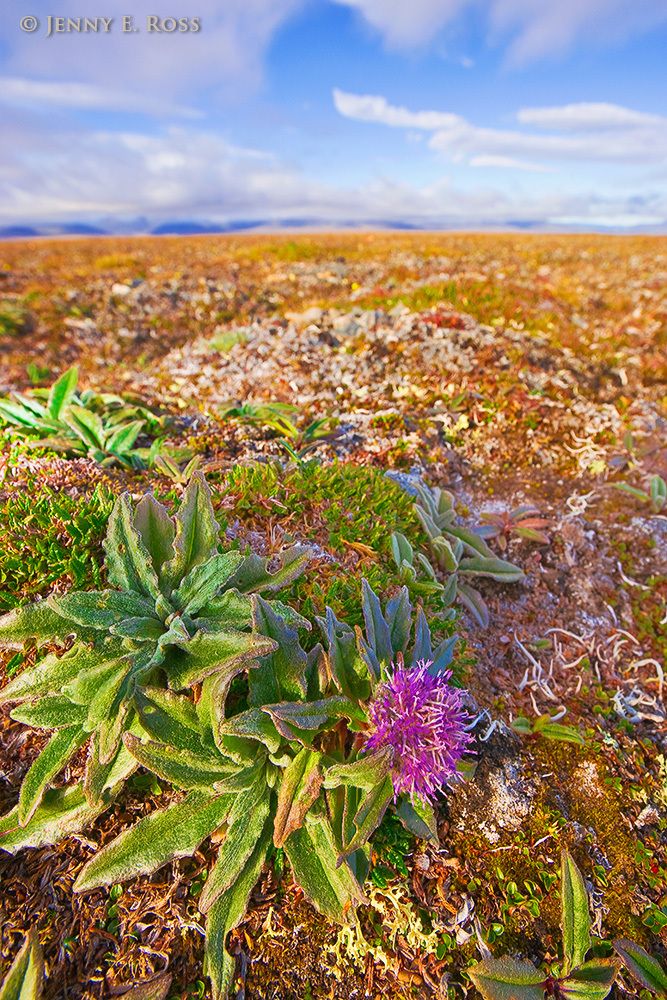
Tundra Wildlflower, Wrangel Island, Russian High Arctic.
Narrow-leaf saw-wort (Saussurea angustifolia) on arctic tundra, Wrangel Island, Siberia, Chukchi Sea (Arctic Ocean), Russia.
-
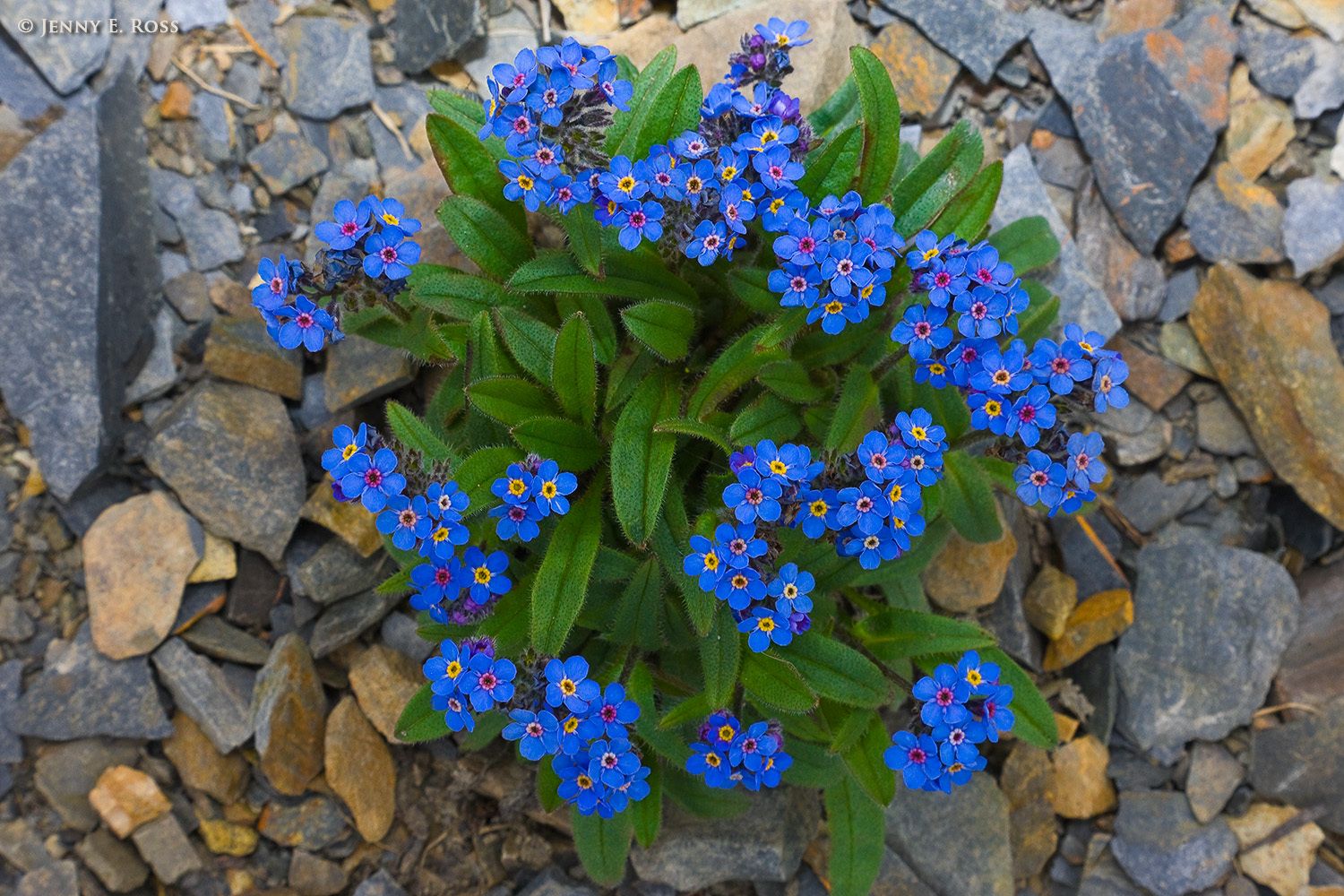
Siberian Forget-Me-Not, Wrangel Island, Russian High Arctic.
Siberian Forget-Me-Not (Myosotis asiatica), Wrangel Island, Siberia, Chukchi Sea (Arctic Ocean), Russia.
-
![Seabirds come and go from their cliffside colony, known as Ptichiy Bazaar, on Wrangel Island in the East Siberian Sea (Arctic Ocean), Russia. The nesting birds at this location include black-legged kittiwakes (Rissa tridactyla), common murres (Uria aalge), and thick-billed murres (Uria lomvia). The common murre is also known as the common guillemot; the thick-billed murre is also known as the Brunnich's guillemot. Seabirds flying and nesting at a cliffside colony on Wrangel Island in the Russian High Arctic.]()
Seabirds flying and nesting at a cliffside colony on Wrangel Island in the Russian High Arctic.
Seabirds come and go from their cliffside colony, known as Ptichiy Bazaar, on Wrangel Island in the East Siberian Sea (Arctic Ocean), Russia. The nesting birds at this location include black-legged kittiwakes (Rissa tridactyla), common murres (Uria aalge), and thick-billed murres (Uria lomvia). The common murre is also known as the common guillemot; the thick-billed murre is also known as the Brunnich's guillemot.
-
![An adult Black-bellied Plover (Pluvialis squatarola), aka Grey Plover, walks along the shore at Cape Florence on Wrangel Island, East Siberian Sea (Arctic Ocean), Russia. Black-bellied plover, Wrangel Island, Russian High Arctic.]()
Black-bellied plover, Wrangel Island, Russian High Arctic.
An adult Black-bellied Plover (Pluvialis squatarola), aka Grey Plover, walks along the shore at Cape Florence on Wrangel Island, East Siberian Sea (Arctic Ocean), Russia.
-
![Arctic Paintbrush (Castilleja elegans) on the tundra of Wrangel Island. Siberia, Chukchi Sea (Arctic Ocean), Russia. Arctic Paintbrush, Wrangel Island, Russian High Arctic.]()
Arctic Paintbrush, Wrangel Island, Russian High Arctic.
Arctic Paintbrush (Castilleja elegans) on the tundra of Wrangel Island. Siberia, Chukchi Sea (Arctic Ocean), Russia.
-
![The tundra is covered with lichens, mosses, and other low-growing arctic plants. Inland from Egvekinot, near the Tadlean River, Chukotka, Siberia, Russia. Arctic Tundra, Chukotka, Siberia, Russia.]()
Arctic Tundra, Chukotka, Siberia, Russia.
The tundra is covered with lichens, mosses, and other low-growing arctic plants. Inland from Egvekinot, near the Tadlean River, Chukotka, Siberia, Russia.
-
![Lichens on rocks, Arctic tundra, Chukotka Autonomous Okrug, Siberia, Russian Federation Lichens on rocks, arctic tundra, Chukotka Autonomous Okrug, Siberia, Russia.]()
Lichens on rocks, arctic tundra, Chukotka Autonomous Okrug, Siberia, Russia.
Lichens on rocks, Arctic tundra, Chukotka Autonomous Okrug, Siberia, Russian Federation
-
![Tufted saxifrage (Saxifraga cespitosa ssp. cespitosa) and other high-arctic flora on a dry slope of arctic desert tundra on George Land in the high-arctic archipelago of Franz Josef Land, Barents Sea (Arctic Ocean), Russia. Tufted Saxifrage on arctic desert tundra, George Land, Franz Josef Land, Russia.]()
Tufted Saxifrage on arctic desert tundra, George Land, Franz Josef Land, Russia.
Tufted saxifrage (Saxifraga cespitosa ssp. cespitosa) and other high-arctic flora on a dry slope of arctic desert tundra on George Land in the high-arctic archipelago of Franz Josef Land, Barents Sea (Arctic Ocean), Russia.
-
![Pacific Walruses (Odobenus rosmarus divergens) swim in the Bering Sea during a summer rainstorm at Cape Onman, Chukotka (Chukchi Peninsula), Siberia, Russia. The walrus needs Arctic sea ice for resting, socialization, giving birth, and nursing young. Because it is an ice-dependent species, scientists believe it is declining due to climate change and the deterioration of its Arctic sea ice habitat. Over-hunting is another significant concern, as is off-shore oil drilling in the Chukchi, Bering and Beaufort Seas. Pacific Walruses swimming in the Bering Sea, Russia.]()
Pacific Walruses swimming in the Bering Sea, Russia.
Pacific Walruses (Odobenus rosmarus divergens) swim in the Bering Sea during a summer rainstorm at Cape Onman, Chukotka (Chukchi Peninsula), Siberia, Russia. The walrus needs Arctic sea ice for resting, socialization, giving birth, and nursing young. Because it is an ice-dependent species, scientists believe it is declining due to climate change and the deterioration of its Arctic sea ice habitat. Over-hunting is another significant concern, as is off-shore oil drilling in the Chukchi, Bering and Beaufort Seas.
-
![Sea birds come and go from their colony on off-shore rocks in the Bering Sea near Verkhoturova Island, Russia. The nesting species include common and Brunnich's guillemots (Uria aalge and Uria lomvia arra -- also known as the common murre and thick-billed murre), glaucous and slaty-backed gulls (Larus hyperboreus and Larus schistisagus), and pelagic cormorants (Phalacrocorax pelagicus). Sea bird colony, Bering Sea near Verkhoturova Island, Russia.]()
Sea bird colony, Bering Sea near Verkhoturova Island, Russia.
Sea birds come and go from their colony on off-shore rocks in the Bering Sea near Verkhoturova Island, Russia. The nesting species include common and Brunnich's guillemots (Uria aalge and Uria lomvia arra -- also known as the common murre and thick-billed murre), glaucous and slaty-backed gulls (Larus hyperboreus and Larus schistisagus), and pelagic cormorants (Phalacrocorax pelagicus).
-
![Steller Sea Lions (Eumetopias jubatus) swim in the Bering Sea near Verkhoturova Island, Russia. The Steller Sea Lion is listed as an Endangered species on the IUCN Red List of threatened and endangered species, and in the Red Data Book of the Russian Federation. Under the U.S. Endangered Species Act, the western population of the Steller Sea Lion (in Russia, and portions of Alaska) is listed as Endangered, and the eastern population (in portions of Alaska, Washington, Oregon, California, and Canada) is listed as Threatened. Steller Sea Lions, Bering Sea near Verkhoturova Island, Russia]()
Steller Sea Lions, Bering Sea near Verkhoturova Island, Russia
Steller Sea Lions (Eumetopias jubatus) swim in the Bering Sea near Verkhoturova Island, Russia. The Steller Sea Lion is listed as an Endangered species on the IUCN Red List of threatened and endangered species, and in the Red Data Book of the Russian Federation. Under the U.S. Endangered Species Act, the western population of the Steller Sea Lion (in Russia, and portions of Alaska) is listed as Endangered, and the eastern population (in portions of Alaska, Washington, Oregon, California, and Canada) is listed as Threatened.
-
![Flowering Monkshood (Aconitum productum?) brightens a steep muddy slope along the Amguema River Estuary in the Chukchi Sea (Arctic Ocean), Chukotka Autonomous Okrug (Siberia), Russia. Monkshood, Amguema River Estuary, Chukchi Sea, Russia.]()
Monkshood, Amguema River Estuary, Chukchi Sea, Russia.
Flowering Monkshood (Aconitum productum?) brightens a steep muddy slope along the Amguema River Estuary in the Chukchi Sea (Arctic Ocean), Chukotka Autonomous Okrug (Siberia), Russia.
-
![Along the Amguema River Estuary, thawing of permafrost is causing steep earthen slopes to slump down into the water along the coast of the Chukchi Sea (Arctic Ocean), Chukotka, Siberia, Russia. Throughout this region, as a consequence of climate warming, cohesion of the ground previously provided by interstitial ice in the soil has deteriorated, causing entire hillsides to become unstable and to collapse. Slumping hillside due to thawing permafrost, Amguema River Estuary, Chukchi Sea, Russia.]()
Slumping hillside due to thawing permafrost, Amguema River Estuary, Chukchi Sea, Russia.
Along the Amguema River Estuary, thawing of permafrost is causing steep earthen slopes to slump down into the water along the coast of the Chukchi Sea (Arctic Ocean), Chukotka, Siberia, Russia. Throughout this region, as a consequence of climate warming, cohesion of the ground previously provided by interstitial ice in the soil has deteriorated, causing entire hillsides to become unstable and to collapse.
-
![Yellow Marsh Saxifrage (Saxifraga hirculus), aka Bog Saxifrage, blooms on the tundra of Wrangel Island, in the Chukchi Sea (Arctic Ocean), Siberia, Russia. Yellow Marsh Saxifrage, Wrangel Island, Russia]()
Yellow Marsh Saxifrage, Wrangel Island, Russia
Yellow Marsh Saxifrage (Saxifraga hirculus), aka Bog Saxifrage, blooms on the tundra of Wrangel Island, in the Chukchi Sea (Arctic Ocean), Siberia, Russia.
-
![Common and Brunnich's Guillemots and Pelagic Cormorants at a portion of a huge cliffside seabird colony on Kolyuchin Island, Chukotka, Chukchi Sea (Arctic Ocean), Russia. Breeding species at the colony include: Horned Puffin (Fratercula corniculata), Tufted Puffin (Fratercula cirrhata); Common Guillemot (Uria aalge, aka Common Murre); Brunnich's Guillemot (Uria lomvia arra, aka Thick-billed Murre); Pelagic Cormorant (Phalacrocorax pelagicus); Black-legged Kittiwake (Rissa tridactyla pollicaris); and Glaucous Gull (Larus hyperboreus). Seabird colony, Kolyuchin Island, Chukchi Sea (Arctic Ocean), Russia.]()
Seabird colony, Kolyuchin Island, Chukchi Sea (Arctic Ocean), Russia.
Common and Brunnich's Guillemots and Pelagic Cormorants at a portion of a huge cliffside seabird colony on Kolyuchin Island, Chukotka, Chukchi Sea (Arctic Ocean), Russia. Breeding species at the colony include: Horned Puffin (Fratercula corniculata), Tufted Puffin (Fratercula cirrhata); Common Guillemot (Uria aalge, aka Common Murre); Brunnich's Guillemot (Uria lomvia arra, aka Thick-billed Murre); Pelagic Cormorant (Phalacrocorax pelagicus); Black-legged Kittiwake (Rissa tridactyla pollicaris); and Glaucous Gull (Larus hyperboreus).
-
![Adult Pelagic Cormorants (Phalacrocorax pelagicus) rest at the edge of their nest alongside their young chicks at a huge cliffside seabird colony on Kolyuchin Island in the Chukchi Sea (Arctic Ocean), Chukotka, Siberia, Russia. In addition to Pelagic Cormorants, breeding species at the colony include Brunnich's Guillemot (Uria lomvia arra, aka Thick-billed Murre); Common Guillemot (Uria aalge inornata, aka Common Murre; Horned Puffin (Fratercula corniculata); Tufted Puffin (Fratercula cirrhata); Black-legged Kittiwake (Rissa tridactyla pollicaris); and Glaucous Gull (Larus hyperboreus). Nesting Pelagic Cormorants, Kolyuchin Island, Chukchi Sea, Russia.]()
Nesting Pelagic Cormorants, Kolyuchin Island, Chukchi Sea, Russia.
Adult Pelagic Cormorants (Phalacrocorax pelagicus) rest at the edge of their nest alongside their young chicks at a huge cliffside seabird colony on Kolyuchin Island in the Chukchi Sea (Arctic Ocean), Chukotka, Siberia, Russia. In addition to Pelagic Cormorants, breeding species at the colony include Brunnich's Guillemot (Uria lomvia arra, aka Thick-billed Murre); Common Guillemot (Uria aalge inornata, aka Common Murre; Horned Puffin (Fratercula corniculata); Tufted Puffin (Fratercula cirrhata); Black-legged Kittiwake (Rissa tridactyla pollicaris); and Glaucous Gull (Larus hyperboreus).
-
![Capitate Valerian (Valeriana capitata) - aka Mountain Heliotrope or Sharpleaf Valerian - with Viviparous Bistort (Polyganum viviparum) on the arctic tundra of Wrangel Island, Siberia, Chukchi Sea (Arctic Ocean), Russia. Capitate Valerian with Viviparous Bistort, Wrangel Island, Russia.]()
Capitate Valerian with Viviparous Bistort, Wrangel Island, Russia.
Capitate Valerian (Valeriana capitata) - aka Mountain Heliotrope or Sharpleaf Valerian - with Viviparous Bistort (Polyganum viviparum) on the arctic tundra of Wrangel Island, Siberia, Chukchi Sea (Arctic Ocean), Russia.
-
![Arctic plants in autumn colors, including Crowberry (Empetrum nigrum), Alpine Bearberry (Arctous alpina), One-sided Wintergreen (Orthilla secunda), and Lapland Cornel (Chamaepericlymenum suecicum) on the tundra at Bukhta Gavriila, Cape Navarin, Bering Sea, Chukotka Autonomous Okrug (Siberia), Russia. Arctic tundra plants in autumn colors, Chukotka, Russia.]()
Arctic tundra plants in autumn colors, Chukotka, Russia.
Arctic plants in autumn colors, including Crowberry (Empetrum nigrum), Alpine Bearberry (Arctous alpina), One-sided Wintergreen (Orthilla secunda), and Lapland Cornel (Chamaepericlymenum suecicum) on the tundra at Bukhta Gavriila, Cape Navarin, Bering Sea, Chukotka Autonomous Okrug (Siberia), Russia.
-
![Pacific Walruses (Odobenus rosmarus divergens) maneuver for position at a small crowded haul-out on the shore of Arakamchechen Island in the Bering Sea, Chukotka, Siberia, Russia. The Pacific Walrus is an Arctic marine mammal that is dependent on the existence of sea ice for resting and breeding. Pacific Walruses, Arakamchechen Island, Bering Sea, Russia.]()
Pacific Walruses, Arakamchechen Island, Bering Sea, Russia.
Pacific Walruses (Odobenus rosmarus divergens) maneuver for position at a small crowded haul-out on the shore of Arakamchechen Island in the Bering Sea, Chukotka, Siberia, Russia. The Pacific Walrus is an Arctic marine mammal that is dependent on the existence of sea ice for resting and breeding.
-
![An adult Pacific Walrus (Odobenus rosmarus divergens) at a small haul-out on Arakamchechen Island in the Bering Sea, Chukotka, Siberia, Russia. The Pacific walrus is an Arctic marine mammal that is dependent on the existence of sea ice for resting and breeding. The species is currently classified by the IUCN as "Data Deficient" because insufficient data currently exist to support a scientific determination of population status and trends. However, there is significant concern about the effects of climate change on this ice-dependent animal, as well as concern about over-hunting. A petition to list the Pacific walrus as a Threatened species under the U.S. Endangered Species Act is currently pending (2009). Pacific Walrus, Arakamchechen Island, Bering Sea, Russia.]()
Pacific Walrus, Arakamchechen Island, Bering Sea, Russia.
An adult Pacific Walrus (Odobenus rosmarus divergens) at a small haul-out on Arakamchechen Island in the Bering Sea, Chukotka, Siberia, Russia. The Pacific walrus is an Arctic marine mammal that is dependent on the existence of sea ice for resting and breeding. The species is currently classified by the IUCN as "Data Deficient" because insufficient data currently exist to support a scientific determination of population status and trends. However, there is significant concern about the effects of climate change on this ice-dependent animal, as well as concern about over-hunting. A petition to list the Pacific walrus as a Threatened species under the U.S. Endangered Species Act is currently pending (2009).
-
![Arctic Cottongrass (Eriophorum callitrix) in a bog at a freshwater stream on the tundra near Ushakovskoye, Wrangel Island, Chukotka (Siberia), Chukchi Sea (Arctic Ocean), Russia. Arctic Cottongrass on tundra, Wrangel Island, Russia.]()
Arctic Cottongrass on tundra, Wrangel Island, Russia.
Arctic Cottongrass (Eriophorum callitrix) in a bog at a freshwater stream on the tundra near Ushakovskoye, Wrangel Island, Chukotka (Siberia), Chukchi Sea (Arctic Ocean), Russia.
-
![Arctic tundra plants in autumn colors, including Crowberry (Empetrum nigrum), Alpine Bearberry (Arctous alpina), One-sided Wintergreen (Orthilla secunda), and Lapland Cornel (Chamaepericlymenum suecicum). Bukhta Gavriila, Cape Navarin, Bering Sea, Chukotka Autonomous Okrug (Siberia), Russia. Tundra plants in autumn colors, Chukotka, Russia]()
Tundra plants in autumn colors, Chukotka, Russia
Arctic tundra plants in autumn colors, including Crowberry (Empetrum nigrum), Alpine Bearberry (Arctous alpina), One-sided Wintergreen (Orthilla secunda), and Lapland Cornel (Chamaepericlymenum suecicum). Bukhta Gavriila, Cape Navarin, Bering Sea, Chukotka Autonomous Okrug (Siberia), Russia.
-
![An adult Glaucous Gull (Larus hyperboreus) at a huge cliffside seabird colony on Kolyuchin Island, Chukotka (Siberia), Russia. In addition to the Glaucous Gull, breeding species at the colony include Brunnich's Guillemot (Uria lomvia arra, aka Thick-billed Murre); Common Guillemot (Uria aalge inornata, aka Common Murre); Horned Puffin (Fratercula corniculata); Tufted Puffin (Fratercula cirrhata); Pelagic Cormorant (Phalacrocorax pelagicus); and Black-legged Kittiwake (Rissa tridactyla pollicaris). Glaucous gull, Kolyuchin Island, Chukchi Sea, Russia]()
Glaucous gull, Kolyuchin Island, Chukchi Sea, Russia
An adult Glaucous Gull (Larus hyperboreus) at a huge cliffside seabird colony on Kolyuchin Island, Chukotka (Siberia), Russia. In addition to the Glaucous Gull, breeding species at the colony include Brunnich's Guillemot (Uria lomvia arra, aka Thick-billed Murre); Common Guillemot (Uria aalge inornata, aka Common Murre); Horned Puffin (Fratercula corniculata); Tufted Puffin (Fratercula cirrhata); Pelagic Cormorant (Phalacrocorax pelagicus); and Black-legged Kittiwake (Rissa tridactyla pollicaris).
-
![A sea bird colony clings to steep cliffs on Verkhoturova Island in the Bering Sea, Russia. Nearly every expanse of exposed rock where a bird can get a foot-hold on the escarpment along this portion of the island's coast is covered with nesting and resting birds. The nesting species include Common and Brunnich's Guillemots (Uria aalge and Uria lomvia arra, aka Common Murre and Thick-billed Murre), Glaucous and Slaty-backed Gulls (Larus hyperboreus and Larus schistisagus), Tufted and Horned Puffins (Fratercula cirrhata and Fratercula corniculata), and Pelagic Cormorants (Phalacrocorax pelagicus). Verkhoturova Island is a tiny island only 3.5 km long, located 45 km north of Karaginsky Island, in the Karaginsky Gulf of the Bering Sea. Russia's Kamchatka Peninsula is 40 km west of Verkhoturova and Karaginsky Islands, across the Litke Strait. Sea bird colony, Verkhoturova Island, Bering Sea, Russia.]()
Sea bird colony, Verkhoturova Island, Bering Sea, Russia.
A sea bird colony clings to steep cliffs on Verkhoturova Island in the Bering Sea, Russia. Nearly every expanse of exposed rock where a bird can get a foot-hold on the escarpment along this portion of the island's coast is covered with nesting and resting birds. The nesting species include Common and Brunnich's Guillemots (Uria aalge and Uria lomvia arra, aka Common Murre and Thick-billed Murre), Glaucous and Slaty-backed Gulls (Larus hyperboreus and Larus schistisagus), Tufted and Horned Puffins (Fratercula cirrhata and Fratercula corniculata), and Pelagic Cormorants (Phalacrocorax pelagicus). Verkhoturova Island is a tiny island only 3.5 km long, located 45 km north of Karaginsky Island, in the Karaginsky Gulf of the Bering Sea. Russia's Kamchatka Peninsula is 40 km west of Verkhoturova and Karaginsky Islands, across the Litke Strait.
-
![A sea bird colony clings to steep cliffs on Verkhoturova Island in the Bering Sea, Russia. Nearly every expanse of exposed rock where a bird can get a foot-hold on the escarpment along this portion of the island's coast is covered with nesting and resting birds. The nesting species include Common and Brunnich's Guillemots (Uria aalge and Uria lomvia arra, aka Common Murre and Thick-billed Murre), Glaucous and Slaty-backed Gulls (Larus hyperboreus and Larus schistisagus), Tufted and Horned Puffins (Fratercula cirrhata and Fratercula corniculata), and Pelagic Cormorants (Phalacrocorax pelagicus). Verkhoturova Island is a tiny island only 3.5 km long, located 45 km north of Karaginsky Island, in the Karaginsky Gulf of the Bering Sea. Russia's Kamchatka Peninsula is 40 km west of Verkhoturova and Karaginsky Islands, across the Litke Strait. Sea bird colony, Verkhoturova Island, Bering Sea, Russia.]()
Sea bird colony, Verkhoturova Island, Bering Sea, Russia.
A sea bird colony clings to steep cliffs on Verkhoturova Island in the Bering Sea, Russia. Nearly every expanse of exposed rock where a bird can get a foot-hold on the escarpment along this portion of the island's coast is covered with nesting and resting birds. The nesting species include Common and Brunnich's Guillemots (Uria aalge and Uria lomvia arra, aka Common Murre and Thick-billed Murre), Glaucous and Slaty-backed Gulls (Larus hyperboreus and Larus schistisagus), Tufted and Horned Puffins (Fratercula cirrhata and Fratercula corniculata), and Pelagic Cormorants (Phalacrocorax pelagicus). Verkhoturova Island is a tiny island only 3.5 km long, located 45 km north of Karaginsky Island, in the Karaginsky Gulf of the Bering Sea. Russia's Kamchatka Peninsula is 40 km west of Verkhoturova and Karaginsky Islands, across the Litke Strait.
-
![An adult male polar bear (Ursus maritimus) patrols the edge of cliff on tiny Herald Island while stranded ashore due to lack of arctic sea ice. Herald Island, Chukchi Sea (Arctic Ocean), Russia. Polar bear on Herald Island, Chukchi Sea, Russia.]()
Polar bear on Herald Island, Chukchi Sea, Russia.
An adult male polar bear (Ursus maritimus) patrols the edge of cliff on tiny Herald Island while stranded ashore due to lack of arctic sea ice. Herald Island, Chukchi Sea (Arctic Ocean), Russia.
-
![A young adult male polar bear (Ursus maritimus) walks along a narrow gravel beach at the base of a cliff on tiny Herald Island while stranded ashore due to lack of arctic sea ice. Herald Island, Chukchi Sea (Arctic Ocean), Russia. Polar bear on Herald Island, Chukchi Sea, Russia.]()
Polar bear on Herald Island, Chukchi Sea, Russia.
A young adult male polar bear (Ursus maritimus) walks along a narrow gravel beach at the base of a cliff on tiny Herald Island while stranded ashore due to lack of arctic sea ice. Herald Island, Chukchi Sea (Arctic Ocean), Russia.
-
![An adult Red-legged Kittiwake (Rissa brevirostris) perched at a large sea bird colony on cliffs of sedimentary rock, towering above the ocean at Cape Monati on Bering Island in Russia's Commander Islands (aka Komandorski Islands). The other nesting species at this location included: Black-legged Kittiwake (Rissa tridactyla pollicaris); Common Guillemot (Uria aalge, aka Common Murre); Brunnich's Guillemot (Uria lomvia arra, aka Thick-billed Murre); Glaucous Gull (Larus hyperboreus); Slaty-backed Gull (Larus schistisagus), and Northern Fulmar (Fulmarus glacialis). The Red-legged Kittiwake is designated as a Vulnerable species on the IUCN Red List of threatened and endangered species. The Commander Islands are in the Bering Sea east of the Kamchatka Peninsula, a sub-Arctic region. Red-legged Kittiwake, Cape Monati, Bering Island, Commander Islands, Russia.]()
Red-legged Kittiwake, Cape Monati, Bering Island, Commander Islands, Russia.
An adult Red-legged Kittiwake (Rissa brevirostris) perched at a large sea bird colony on cliffs of sedimentary rock, towering above the ocean at Cape Monati on Bering Island in Russia's Commander Islands (aka Komandorski Islands). The other nesting species at this location included: Black-legged Kittiwake (Rissa tridactyla pollicaris); Common Guillemot (Uria aalge, aka Common Murre); Brunnich's Guillemot (Uria lomvia arra, aka Thick-billed Murre); Glaucous Gull (Larus hyperboreus); Slaty-backed Gull (Larus schistisagus), and Northern Fulmar (Fulmarus glacialis). The Red-legged Kittiwake is designated as a Vulnerable species on the IUCN Red List of threatened and endangered species. The Commander Islands are in the Bering Sea east of the Kamchatka Peninsula, a sub-Arctic region.
-
![A Red-legged Kittiwake (Rissa brevirostris) perches alongside Black-legged Kittiwakes (Rissa tridactyla pollicaris) on a narrow ledge at a large sea bird colony on cliffs of sedimentary rock that tower above the ocean at Cape Monati on Bering Island in Russia's Commander Islands (aka Komandorski Islands). The nesting species at this location included: Red-legged Kittiwake (Rissa brevirostris); Black-legged Kittiwake (Rissa tridactyla pollicaris); Common Guillemot (Uria aalge), aka Common Murre; Brunnich's Guillemot (Uria lomvia arra), aka Thick-billed Murre; Glaucous Gull (Larus hyperboreus); Slaty-backed Gull (Larus schistisagus), and Northern Fulmar (Fulmarus glacialis). The Red-legged Kittiwake is designated as a Vulnerable species on the IUCN Red List of threatened and endangered species. The Commander Islands are in the Bering Sea east of the Kamchatka Peninsula, a sub-Arctic region. A Red-legged Kittiwake with Black-legged Kittiwakes, Bering Island, Russia.]()
A Red-legged Kittiwake with Black-legged Kittiwakes, Bering Island, Russia.
A Red-legged Kittiwake (Rissa brevirostris) perches alongside Black-legged Kittiwakes (Rissa tridactyla pollicaris) on a narrow ledge at a large sea bird colony on cliffs of sedimentary rock that tower above the ocean at Cape Monati on Bering Island in Russia's Commander Islands (aka Komandorski Islands). The nesting species at this location included: Red-legged Kittiwake (Rissa brevirostris); Black-legged Kittiwake (Rissa tridactyla pollicaris); Common Guillemot (Uria aalge), aka Common Murre; Brunnich's Guillemot (Uria lomvia arra), aka Thick-billed Murre; Glaucous Gull (Larus hyperboreus); Slaty-backed Gull (Larus schistisagus), and Northern Fulmar (Fulmarus glacialis). The Red-legged Kittiwake is designated as a Vulnerable species on the IUCN Red List of threatened and endangered species. The Commander Islands are in the Bering Sea east of the Kamchatka Peninsula, a sub-Arctic region.
-
![Adult Horned Puffins (Fratercula corniculata) at a huge cliffside seabird colony on Kolyuchin Island in the Chukchi Sea (Arctic Ocean), Chukotka (Siberia), Russia. In addition to the Horned Puffin, breeding species at the colony include the Tufted Puffin (Fratercula cirrhata); Common Guillemot (Uria aalge aka common murre); Brunnich's Guillemot (Uria lomvia arra, aka Thick-billed Murre; Pelagic Cormorant (Phalacrocorax pelagicus); Black-legged Kittiwake (Rissa tridactyla pollicaris); and Glaucous Gull (Larus hyperboreus). Horned Puffins, Kolyuchin Island, Chukchi Sea, Russia.]()
Horned Puffins, Kolyuchin Island, Chukchi Sea, Russia.
Adult Horned Puffins (Fratercula corniculata) at a huge cliffside seabird colony on Kolyuchin Island in the Chukchi Sea (Arctic Ocean), Chukotka (Siberia), Russia. In addition to the Horned Puffin, breeding species at the colony include the Tufted Puffin (Fratercula cirrhata); Common Guillemot (Uria aalge aka common murre); Brunnich's Guillemot (Uria lomvia arra, aka Thick-billed Murre; Pelagic Cormorant (Phalacrocorax pelagicus); Black-legged Kittiwake (Rissa tridactyla pollicaris); and Glaucous Gull (Larus hyperboreus).
-
![Flocks of guillimots and auklets fly above a stormy sea in front of steep cliffs rising from the Bering Strait at Cape Dezhnev, Chukotka, Russia. Cape Dezhnev is the easternmost point on the Eurasian continent, and is situated directly across the Bering Strait from the United States. A strategically-located Russian Cold War outpost, a weather station, and a Gulag were once located at the Cape. Now all uses of the site have been abandoned. There are still several crumbling buildings, an assortment of old equipment and 20th Century artifacts, and a monument to Semyon Dezhnyov, who was the first recorded European to see the Cape and determine that it marked the edge of the Eurasian continent, in 1648. Prior to the early-to-mid 20th century, Cape Dezhnev was also used by indigenous people. Atop the cliff there is a site similar to Arakamchechen Island's famous Whale Bone Alley, where the bones of whales are arranged upright. Nearby are the remains of ancient stone dwellings and food caches. Eastern Edge of Eurasian Continent, Cape Dezhnev, Bering Strait, Russia.]()
Eastern Edge of Eurasian Continent, Cape Dezhnev, Bering Strait, Russia.
Flocks of guillimots and auklets fly above a stormy sea in front of steep cliffs rising from the Bering Strait at Cape Dezhnev, Chukotka, Russia. Cape Dezhnev is the easternmost point on the Eurasian continent, and is situated directly across the Bering Strait from the United States. A strategically-located Russian Cold War outpost, a weather station, and a Gulag were once located at the Cape. Now all uses of the site have been abandoned. There are still several crumbling buildings, an assortment of old equipment and 20th Century artifacts, and a monument to Semyon Dezhnyov, who was the first recorded European to see the Cape and determine that it marked the edge of the Eurasian continent, in 1648. Prior to the early-to-mid 20th century, Cape Dezhnev was also used by indigenous people. Atop the cliff there is a site similar to Arakamchechen Island's famous Whale Bone Alley, where the bones of whales are arranged upright. Nearby are the remains of ancient stone dwellings and food caches.
-
![Arctic Cottongrass (Eriophorum callitrix) in a bog at a freshwater stream on the tundra near Ushakovskoye, Wrangel Island, Chukotka Autonomous Okrug, Chukchi Sea (Arctic Ocean), Russia. Arctic Cottongrass on boggy tundra, Wrangel Island, Russia.]()
Arctic Cottongrass on boggy tundra, Wrangel Island, Russia.
Arctic Cottongrass (Eriophorum callitrix) in a bog at a freshwater stream on the tundra near Ushakovskoye, Wrangel Island, Chukotka Autonomous Okrug, Chukchi Sea (Arctic Ocean), Russia.
-
![Low-growing plants adorning the arctic tundra include Crowberry (Empetrum nigrum), Alpine Bearberry (Arctous alpina), One-sided Wintergreen (Orthilla secunda), and Lapland Cornel (Chamaepericlymenum suecicum). Bukhta Gavriila, Cape Navarin, Chukotka Autonomous Okrug (Siberia), Russia. Tundra plants in autumn colors, Chukotka Autonomous Okrug (Siberia), Russia]()
Tundra plants in autumn colors, Chukotka Autonomous Okrug (Siberia), Russia
Low-growing plants adorning the arctic tundra include Crowberry (Empetrum nigrum), Alpine Bearberry (Arctous alpina), One-sided Wintergreen (Orthilla secunda), and Lapland Cornel (Chamaepericlymenum suecicum). Bukhta Gavriila, Cape Navarin, Chukotka Autonomous Okrug (Siberia), Russia.
-
![Dramatic light from an approaching autumn storm illuminates the tundra and the raised topography of freeze-thaw features on the ground at Onekotan Island in the Kuril Islands, Sea of Okhotsk, Russia. Approaching autumn storm over tundra, Onekotan Island, Kuril Islands, Russia.]()
Approaching autumn storm over tundra, Onekotan Island, Kuril Islands, Russia.
Dramatic light from an approaching autumn storm illuminates the tundra and the raised topography of freeze-thaw features on the ground at Onekotan Island in the Kuril Islands, Sea of Okhotsk, Russia.
-
![Slaty-backed Gulls (Larus schistisagus) and Black-legged Kittiwakes (Rissa tridactyla) on the shore of Verkhoturova Island, Bering Sea, Russia. Verkhoturova Island is a tiny island only 3.5 km long, located 45 km north of Karaginsky Island, in the Karaginsky Gulf of the Bering Sea. Russia's Kamchatka Peninsula is 40 km west of Verkhoturova and Karaginsky Islands, across the Litke Strait. Seabirds at Verkhoturova Island, Bering Sea, Russia.]()
Seabirds at Verkhoturova Island, Bering Sea, Russia.
Slaty-backed Gulls (Larus schistisagus) and Black-legged Kittiwakes (Rissa tridactyla) on the shore of Verkhoturova Island, Bering Sea, Russia. Verkhoturova Island is a tiny island only 3.5 km long, located 45 km north of Karaginsky Island, in the Karaginsky Gulf of the Bering Sea. Russia's Kamchatka Peninsula is 40 km west of Verkhoturova and Karaginsky Islands, across the Litke Strait.
-
![Immature black-legged kittiwake (Rissa tridactyla), swimming in a small freshwater pond near the shore of Verkhoturova Island, Bering Sea, Russia. The autumn colors of nearby tundra vegetation are reflected in the water. Immature Black-legged Kittiwake, Verkhoturova Island, Bering Sea, Russia.]()
Immature Black-legged Kittiwake, Verkhoturova Island, Bering Sea, Russia.
Immature black-legged kittiwake (Rissa tridactyla), swimming in a small freshwater pond near the shore of Verkhoturova Island, Bering Sea, Russia. The autumn colors of nearby tundra vegetation are reflected in the water.
-
![An immature Black-legged Kittiwake (Rissa tridactyla), flying near Verkoturova Island, Bering Sea, Russia.]()
An immature Black-legged Kittiwake (Rissa tridactyla), flying near Verkoturova Island, Bering Sea, Russia.
-
![Brightly-colored tundra plants, including Lapland Cornel (Chamaepericlymenum suecicum), adorn the sub-Arctic tundra in autumn at Bukhta Gavriila, Cape Navarin, Bering Sea, Chukotka Autonomous Okrug (Siberia), Russia. Tundra plants in autumn colors, Cape Navarin, Bering Sea, Russia.]()
Tundra plants in autumn colors, Cape Navarin, Bering Sea, Russia.
Brightly-colored tundra plants, including Lapland Cornel (Chamaepericlymenum suecicum), adorn the sub-Arctic tundra in autumn at Bukhta Gavriila, Cape Navarin, Bering Sea, Chukotka Autonomous Okrug (Siberia), Russia.
-
![The low-growing plants on the tundra here include crowberry (Empetrum nigrum), alpine bearberry (Arctous alpina), one-sided wintergreen (Orthilla secunda), and Lapland Cornel (Chamaepericlymenum suecicum). Bukhta Gavrilla, Cape Navarin, Chukotka Autonomous Okrug (Siberia), Bering Sea, Russia. Tundra plants in autumn colors at Cape Navarin, Bering Sea, Russia.]()
Tundra plants in autumn colors at Cape Navarin, Bering Sea, Russia.
The low-growing plants on the tundra here include crowberry (Empetrum nigrum), alpine bearberry (Arctous alpina), one-sided wintergreen (Orthilla secunda), and Lapland Cornel (Chamaepericlymenum suecicum). Bukhta Gavrilla, Cape Navarin, Chukotka Autonomous Okrug (Siberia), Bering Sea, Russia.
-
![The sun sets behind Wrangel Island in the Chukchi Sea (Arctic Ocean), Russia. Wrangel Island is situated where the East Siberian and Chukchi Seas meet, 140 km off the north coast of Chukotka (northeastern Siberia). In the Late Pleistocene, Wrangel Island was connected to the mainland of Siberia and formed a part of the Bering land bridge (aka Beringia), an area including Chukotka, Alaska, and the now-submerged continental shelf. Wrangel Island became separated from the Eurasian continent in the early Holocene epoch, around 10,000 years ago. The island provided the final refugium for a population of woolly mammoths (Mammuthus primigenius) that survived into the Holocene, until approximately 3700 years ago. Wrangel Island at sunset, Chukchi Sea, Russia.]()
Wrangel Island at sunset, Chukchi Sea, Russia.
The sun sets behind Wrangel Island in the Chukchi Sea (Arctic Ocean), Russia. Wrangel Island is situated where the East Siberian and Chukchi Seas meet, 140 km off the north coast of Chukotka (northeastern Siberia). In the Late Pleistocene, Wrangel Island was connected to the mainland of Siberia and formed a part of the Bering land bridge (aka Beringia), an area including Chukotka, Alaska, and the now-submerged continental shelf. Wrangel Island became separated from the Eurasian continent in the early Holocene epoch, around 10,000 years ago. The island provided the final refugium for a population of woolly mammoths (Mammuthus primigenius) that survived into the Holocene, until approximately 3700 years ago.




















